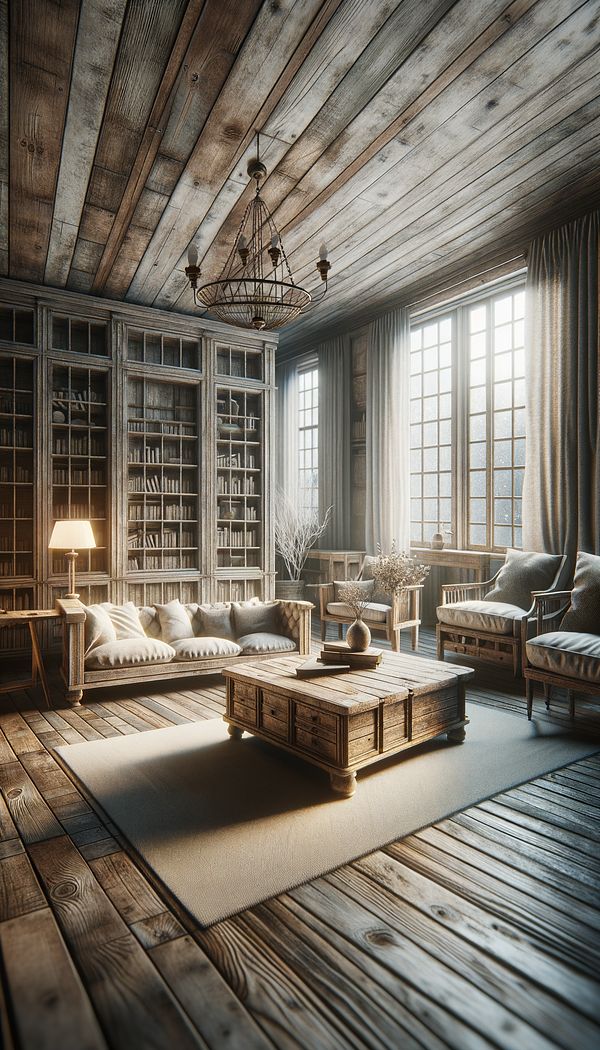What is Distressed?
Distressed refers to a finish or treatment that gives an object a worn, aged, or antique appearance.
Description
When we talk about distressed in the context of interior design, we're referring to a specific finish or treatment applied to various elements like furniture, wood, metal, or even fabric, to give them a worn, aged appearance. This technique is often employed to add character and a sense of history to new pieces, making them appear as though they've been part of a space for generations. Distressed finishes can range from lightly weathered to heavily antiqued, with the degree of distressing intentionally controlled during the finishing process.
The concept of distressing isn't new. It has roots in various design styles, particularly in shabby chic, country, rustic, and vintage interiors, where it helps to create a homely, lived-in feel. By incorporating distressed pieces, designers can add depth and personality to a room, weaving in stories of imaginary pasts that evoke nostalgia and comfort. This approach is versatile, finding its place not only in residential settings but also in commercial spaces like cafes and boutiques, where it contributes to a welcoming, authentic atmosphere.
Let's not forget that the process of distressing isn't just about aesthetics; it's a skilled technique that requires an understanding of the material being distressed and the overall design vision. It can involve various methods, ranging from sanding, scraping, and painting to applying specific finishing products that accelerate aging or mimic the effects of wear and tear.
Usage
A common application of the distressed finish is in furniture, where items such as tables, chairs, cabinets, and mirrors are given a vintage look that adds warmth and character to a space. It's also seen in home décor elements like picture frames, light fixtures, and even wall treatments, where a distressed effect can serve as a focal point or contribute to a cohesive design theme.
FAQs
-
Can any material be distressed?
Virtually, yes. While wood, metal, and leather are the most commonly distressed materials in interior design, innovative techniques allow for the distressing of fabric, glass, and even plastic to achieve the desired aged look.
-
Is distressed the same as antique?
Not exactly. While both aims to evoke a sense of age and history, 'antique' refers to items that are genuinely old—generally over 100 years—while 'distressed' refers to a finish applied to make new items appear aged.
-
How do I maintain distressed furniture?
Distressed furniture doesn't require extensive maintenance. Regular dusting and occasional wiping with a damp cloth should suffice. Avoid using harsh chemicals or abrasive cleaners, as they might remove the distressed finish.
Practical Application
When incorporating distressed items into your design, aim for balance. A few strategically placed pieces can bring warmth and depth, but overdoing it may overwhelm the space. Consider pairing distressed furniture with smoother, modern elements to create contrast and keep the look fresh. Understanding the overall design styles of your space can guide in selecting the right distressed pieces to complement your interior.
-
Design Styles478 articles
-
Furniture Types599 articles
-
Decorative Techniques322 articles
-
Textiles & Upholstery252 articles
-
Wall Treatments & Finishes157 articles
-
Court CupboardA Court Cupboard is a type of wooden sideboard or cabinet.
-
GlassGlass is a hard, brittle, and typically transparent material, made by fusing sand with soda ash and lime, and cooled rapidly.
-
StainingStaining is the application of pigment to a surface to change its color and enhance its grain.
-
Gothic RevivalGothic Revival is a design style that reinterprets the architecture, interiors, and decorative arts of the Gothic period.
-
Mirror StandA mirror stand is a freestanding frame or support designed to hold a mirror.
